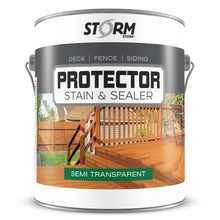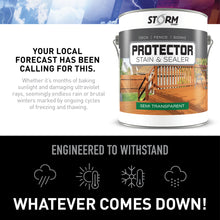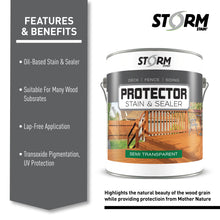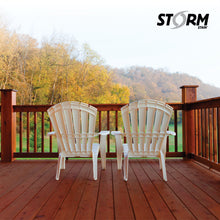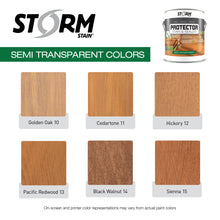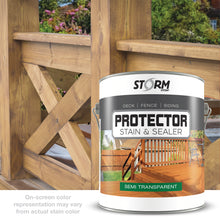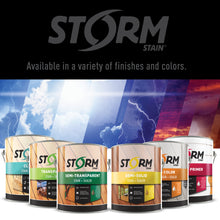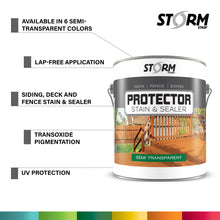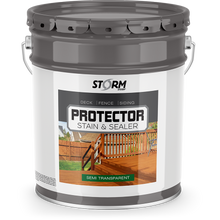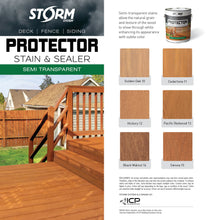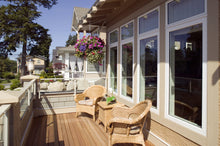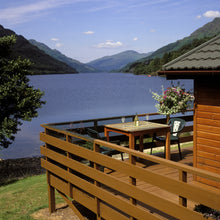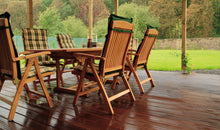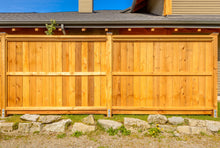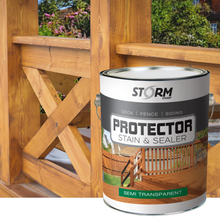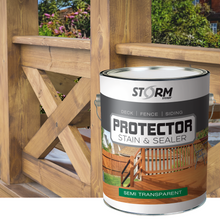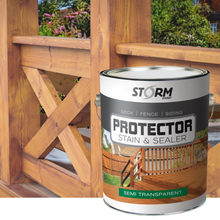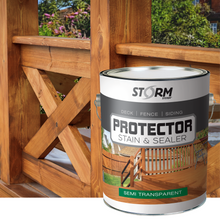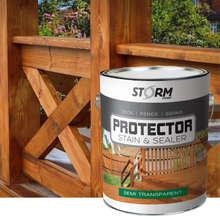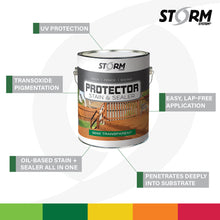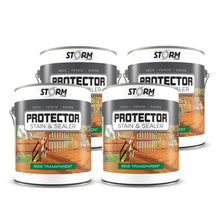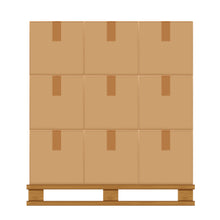
About this Product
Storm Protector is a Semi-Transparent penetrating stain and sealer meant to protect and highlight the natural beauty of the wood grain. With higher solids and pigment levels than other products in the marketing, Storm Protector offers better waterproofing capabilities and UV protections against color fade. The oil resins used in Protector will penetrate further into the wood, providing more protection from Mother Nature.
Storm Protector can be applied to any exterior wood, including Redwood, Cedar, Pine, Douglas Fir, Spruce, Cypress, Mahogany and Pressure Treated lumber.
*Product holds a three-year shelf-life after manufacture date stamped on lid
Protect your exterior wood surfaces and highlight the natural beauty of the wood grain with Storm Stain Protector Semi-Transparent Stain and Sealer. This wood sealer for outdoor surfaces penetrates deep to provide additional protection from Mother Nature. It offers superior waterproofing and UV protection to help prevent color fading. It can be applied to any exterior wood, including redwood, cedar, pine, douglas fir, spruce, cypress, mahogany and pressure treated lumber. With a ready-to-use formula, Storm Protector outdoor wood sealer and stain is easy to apply. Mix thoroughly and apply to a prepared wood surface with a brush, roller, pump or airless sprayer. Follow directions on packaging.
There's nothing quite like the authentic, natural look and feel of exterior wood surfaces. Storm Stain was created to make it easy to keep your exterior wood looking beautiful and provide protection against extreme weather conditions. From clear finishes to more dramatic, solid color stains, Storm Stain offers whatever look you want as well as the protection to weather whatever.
Product Specifications:
- STORM PROTECTOR: Storm Protector is a penetrating, semi-transparent stain and sealer that highlights the natural beauty of the wood grain while providing protection from Mother Nature.
- PROTECT YOUR EXTERIOR WOOD SURFACES: This siding, deck and fence stain and sealer offers superior waterproofing and UV protection to help prevent color fading.
- FOR A VARIETY OF WOOD SUBSTRATES: Storm Protector exterior wood stain and sealer can be applied to any exterior wood, including redwood, cedar, pine, douglas fir, spruce, cypress, mahogany and pressure treated lumber.
- EASY TO APPLY: Storm Protector features a ready-to-use formula that's easy to apply. Mix thoroughly and apply to a prepared wood surface with a brush, roller, or sprayer.
- PROTECTION TO WEATHER WHATEVER: From clear finishes that protect wood and highlight its natural beauty to more dramatic solid color stains, Storm Stain offers the look you want as well as the protection to weather whatever.
SURFACE PREPARATION
Surfaces must be thoroughly cleaned of all dirt and dust. All prior coatings must be completely removed, prior to applications. Surfaces should be washed with Storm All Surface Cleaner (30210). If Mold and Mildew are present, wash surface with Storm All Surface Mold and Mildew Cleaner (40210). Be sure that any cleaning agents, or chemical strippers are fully washed off or neutralized. Grease, oils and wax should be removed by solvent cleaning to insure proper penetration. For proper penetration and adhesion, Aged/Gray wood must be sanded down to ensure all deal wood fibers are removed. All wood species must have a moisture content of 15% or less.
APPLICATION
Prior to application, a test should be performed on the actual species of wood being used before larger areas of wood are finished. Storm Protector comes ready to use as it comes from the container. Stir thoroughly before use. Mix multiple gallons together in a separate container to ensure uniform color. Storm Protector can be applied by brush, roller, pump sprayer or airless sprayer.
DO NOT THIN. Stir product continuously during application, to ensure proper color uniformity.
CLEAN UP
- Clean tools and equipment with mineral spirits or turpentine. Do not use water on natural bristle or china bristle brushes.
ARCHITECTURAL SPECIFICATIONS
- Redwood, Cedar, Pine, Douglas Fir, Spruce, Cypress, Mahogany, Pressure Treated
- 1 Coat Storm Protector
- Properly Prepared Weathered Wood
- 2 Thin Coats of Storm Protector
PRECAUTIONS
- Do not apply this product to gray/aged wood.
- Do not apply this product over previously stained or painted surfaces.
- Appearance will vary with the different varieties of wood.
- Samples should be tested on the actual wood being used before large areas of wood are finished.
- Stir product continuously during application to ensure proper color uniformity.
Refer to Safety Data Sheet for additional health and safety information.
Refer to Technical Data Sheet for additional application details and further information.
Ten Professional Wood Staining Tips
When it comes time to stain your deck, fence, or other outdoor wood surface, it is important to catch up on some “wood finishing 101,” by becoming aware of potential dilemmas you may run into if the wood is not prepared and maintained properly. From oil-based vs. water-based (latex; acrylic) stains, to deck stain color ideas, all these wood staining tips should be taken into consideration before you start your project to achieve a perfectly stained finish!
Choosing the Correct Stain
When it comes to your outdoor wood-staining project, it is important to make sure you choose the best type of stain for your wood. Some key ideas that should be taken into consideration when choosing a stain are: “Is the wood new or existing?” “What level of protection does the wood need from outdoor elements (UV, rain, etc.)?” “Do I want a color or clear stain?” “Has the wood been treated previously (how will this interfere/effect the stain)?” Once these questions have been answered regarding your specific project, it will give you a more clear idea of the type of stain to utilize and then you can decide where to buy it from a local retailer. Whether its transparent, semi-transparent, solid or semi-solid, choosing the right stain is a vital part of the process.
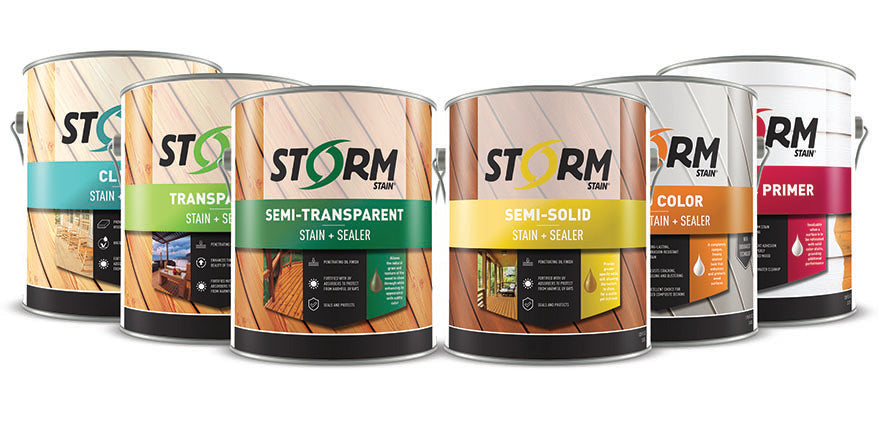
Using weather color-coding and phrases, Storm System is organized in five categories based on the level of opacity, degree of UV protection, and typical longevity of each finish.
Varnished Surface
If the piece of wood you are applying stain to already has a coat of varnish on it, it will hinder the stain's ability to penetrate the wood properly, as it acts as a barrier between the two. Varnish protects against water and moisture, thus will not allow the stain to set properly on the wood's surface and will lead to it flaking off. In order to avoid this problem, it is necessary to sand the wood so that the varnished coat is removed completely before you get started with applying the new stain. Whenever sanding wood before treatment, always sand with the grain as even minor scratches will be highly visible after staining!
Types of Wood
Different kinds of wood react differently to stains being applied to their surface. Before beginning the wood staining process, it will help to avoid any issues in color acceptance by first applying a quality base primer to prepare the wood for the application. This will create a consistent base so that the wood reacts positively to the stain and does not appear blotchy and uneven. With some research, you will find there are interactive widgets for selecting the right category of stain depending on your wood type and outdoor needs. It's always a good idea to test your stain on scrap wood to ensure it's ready to apply (and what you ordered at the store).
Humidity and Moisture
One common wood staining issue comes about when the wood is holding moisture and is not completely dry. It is imperative to make sure the wood has dried inside and outside before starting the process of staining. If this is not taken into consideration, the applied layers will likely flake off and will no longer be protecting the wood's surface. When it comes to treated wood and holding moisture, one deck-staining tip is to wait 6 weeks to allow for a thorough dehydration of the wood and also it is recommended to stain on a warm, dry day.
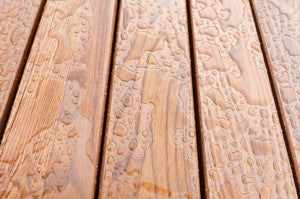
Wood must be fully dry before treating it!
Stain is Too Thick
Often times if the stain has been sedentary for longer periods of time, it becomes thick in volume. This can lead to uneven application, and the wood to not be protected properly. One wood staining technique to avoid this issue is to add a compatible thinner to the stain in order to get a product that will supply a smooth application.
Sawdust Layer
When wood is cut and manufactured, it is often covered in a layer or sawdust. It most likely still contains this coating when you receive it, and this will prohibit a proper stain application. To remove this covering from the surface, you will need to use cloths that have some stick in their surface and wipe the wood down thoroughly. For large projects, you will likely want to use a power washer to prepare your surfaces instead. Regardless if you are chipping off old paint, or simply rinsing, give the wood surface a full day of sun to dry out before continuing to treat it. If this step is not done before the stain application, sawdust blocking the wood's pores will result in an appearance that is uneven and blotchy.
Oil-Based vs. Water-Based Stains (Latex/Acrylic)
When assessing your potential gallery of color ideas for your choice of stain, it is important to consider if you will go the route of oil or water based stain. Water-based color stains generally provide a much richer color than oil based stains. Water-based stains also do not emit the fumes that oil ones do. Oil-based stains provide a thicker seal, which allows for a high level of protection. In addition, they are more durable and do not need to be maintained nearly as much as water-based stains. Water-based stain is applied the in the same way as oil-based, although your brush choice should be different. For water-based wood stains, a synthetic brush (such as nylon or polyester) is best. For oil-based wood stains, use a natural bristle brush. In either case, plan to spend a little extra for a good-quality brush, which will lay coatings on the wood smoothly and will leave less stray bristles in your coatings.
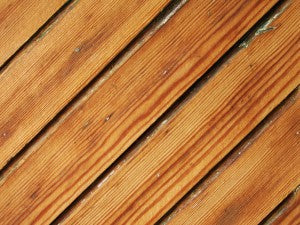
Don't forget you are protecting your wood!
Be sure that all the exposed surfaces are protected (not just the top!)
Saw Cuts
When a deck is constructed, the wood needs to be sized, which lead to saw cuts. Saw cuts expose the end grain of the pieces of wood, which can potentially allow for a major entrance of moisture. One deck-staining tip that allows for proper care of these cuts is to stack them with spacers so that the air can move through the wood and thoroughly dry it. Once the wood has been provided the proper time to completely dry out, a sealer should be applied to the saw cuts and also the backside of the wood (if not, it can cause cupping) to ensure all surfaces are protected once the deck is built!
Using Multiple Buckets
If you are attempting to stain a large wooden surface that requires multiple buckets of stain, one way to stain your deck like a professional is to combine all the buckets into one mixture. Although the stains are all supposed to be the same color, occasionally they can vary slightly, so mixing them all together will prevent uneven color appearance over the entire area.
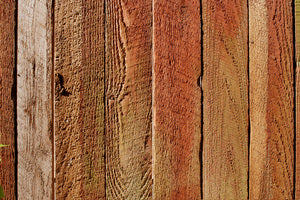
An even application will be crucial for uniform appearance (and weathering).
How to Fix/Prevent Blotchy Patches
If you didn't prepare your deck for harsh enough conditions and treat the wood surfaces properly, the newly-applied stain can dry in blotchy patches, which are not visually appealing nor does it provide uniform protection. In order to achieve an evenly stained deck, before starting staining apply a thin coat of wood conditioner with an inexpensive brush. After waiting 15 minutes to allow drying, apply stain while making sure to wipe away any excess stain and only apply in light coats. Wipe away excess stain immediately using a cloth, and if it does not appear flawless after the first coat, a second can always be applied if you follow the rules of a light application.
Storm System Protector Stain & Sealer Golden Oak (291110) SDS
Storm System Protector Stain & Sealer Cedartone (291111) SDS
Storm System Protector Stain & Sealer Hickory (291112) SDS
Storm System Protector Stain & Sealer Pacific Redwood (291113) SDS
Storm System Protector Stain & Sealer Black Walnut (291114) SDS
Storm System Protector Stain & Sealer Sienna (291115) SDS
- Choosing a selection results in a full page refresh.
- Press the space key then arrow keys to make a selection.

